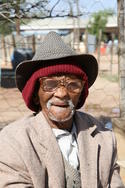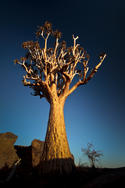Explore, Collect, Trade

Not all the Europeans who entered Namaqualand were focused on conquest. Many entered the region to explore, collect, trade and hunt. Johannes Rhenius, for example, went on two unsuccessful trading missions to Garies in 1721 and 1724.
Co-incidentally, Rhenius was the son-in-law of Olof Bergh, who had pioneered the northern ‘highway’ in 1682. The various hunters who prowled around the region are harder to identify. They didn’t keep journals and often travelled secretly, without permission. Nevertheless, members of these hunting parties are generally considered to be the first white people to see the Orange River.
This may have occurred as early as 1728, when a group of farmers from Piketberg surreptitiously travelled to the north on an extended hunting trip. Here, they came across the wide river known to the locals as the Gariep (Great River). It is also said that they met another white man on the shores of the Gariep, an elephant hunter named Pieter de Bruyn. This account, however, remains somewhat conjectural.
For All the Wrong Reasons
Another expedition, in 1739, did make it into the official records, but for all the wrong reasons. This group of hunters crossed over the Orange into Great Namaqualand (Namibia) where they spent a month at the kraal of Chief Gal.
When they left, they persuaded their servants to raid the kraal and steal the cattle, in exchange for a share of the profits. Then, as they rode south through Little Namaqualand, they continued raiding kraals as they went, stealing more than 1000 cattle and killing several women and children. All of this came to light after representatives from the aggrieved parties travelled to the Cape to protest.
Even the servants who had done the raiding complained that they had not been given the cattle they were promised. In the face of popular support for the hunters, the Company decided to confiscate the stolen cattle and keep it for themselves! The first ‘official’ visit to the !Gariep is credited to Jacobus Jansz Coetse who undertook the journey in 1760.
He was a farmer from Piketberg who went off to hunt elephants, leaving his wife to look after the family farm. Suitably unencumbered, Coetse travelled with two wagons and twelve Khoikhoi, traversing Namaqualand until he came to the banks of the !Gariep. He crossed the river at Ramansdrift near Gu-daos (the sheep path).
This was a river crossing that was often used by the Namaqua herders, and it is now known by the corrupted name ‘Goodhouse’. In this unassuming manner, Coetse became the first white person to document his journey across the lower Orange River into the country of the Great Namaqua.
A Semi-Official Expedition

Following Coetse’s journey, it was decided that a semi-official expedition should go out to explore the region north of the !Gariep. This was led by Hendrik Hop, who set out with fifteen wagons in 1761. Jacobus Coetse went along as guide and Carel Brink acted as the chronicler.
According to Brink, the Namaqua they met along the way were poor, had few cattle and were constantly being raided by ‘Bosjesmans’. Hop’s party crossed the river at Gu-daos and continued north to the Keetmanshoop area. ere, they were forced to turn back because of the hot and dry summer conditions.
Another member of the Hop expedition, Dr. Carel Rykvoet, took the opportunity to do some mineralogical investigations while he was in the area. He examined Van der Stel’s Copper Mountain and declared the deposits to be poor. He also ventured into the Richtersveld, west of Gu-daos, where he found deposits that were very rich – up to one third copper.
However, he realised that the rocks were too hard, the land too barren and the distances too great for the minerals to be exploited.
By David Fleminger